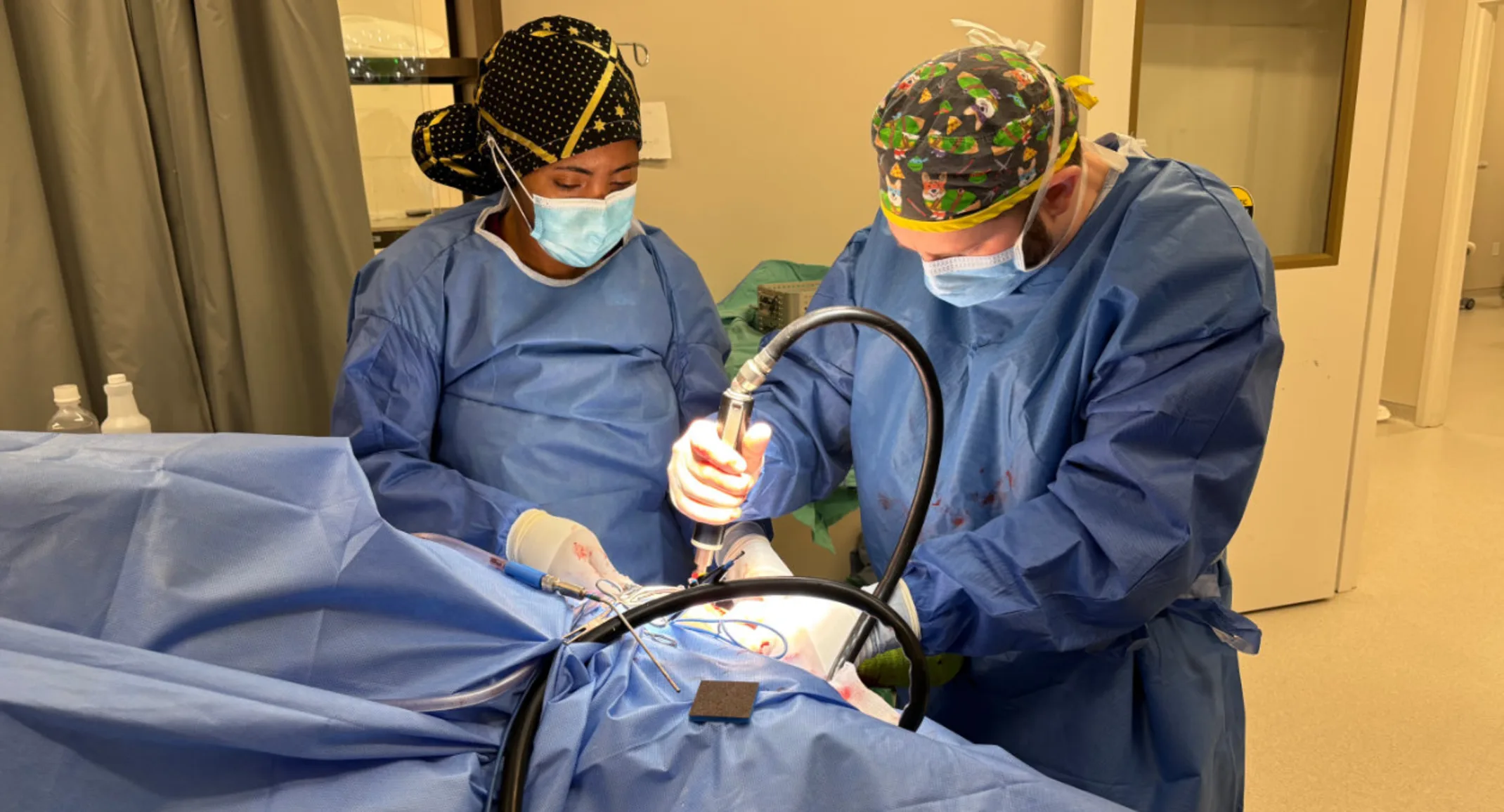What Dog Owners Should Know About TPLO Surgery
Surgery

Ethos Veterinary Health: Virginia Veterinary Centers Fredericksburg
Tibial Plateau Leveling Osteotomy
March 2025
______________________________________________________________________________
What Dog Owners Should Know About TPLO Surgery
Cranial cruciate ligament (CCL) injuries are among the most common orthopedic conditions in dogs. In many cases, a tibial plateau leveling osteotomy (TPLO) is the best option for a full recovery. If your dog has a CCL injury, you may be wondering what a TPLO procedure involves and how long it will take your dog to recover. Our experienced team of orthopedic surgeons has performed many TPLO surgeries, and wants to help you understand what to expect if your dog has a ruptured CCL.
What is cranial cruciate ligament disease in dogs?
A dog’s CCL is comparable to a human’s anterior cruciate ligament (ACL). This ligament is responsible for stabilizing the knee. CCL rupture can result from activity-related trauma, but is most commonly caused by progressive degeneration of the ligament. Large breed dogs, such as Labrador retrievers, rottweilers, and boxers, are at higher risk for CCL disease. Dogs who are overweight are also more susceptible.
Signs of CCL injury include limping on one or both hind legs, swelling around the knee joint, decreased muscle mass over the affected limb, and difficulty standing up, jumping on or off surfaces, and navigating stairs. Left untreated, a CCL injury can lead to significant arthritis in the joint, resulting in pain and decreased mobility.
Does my dog need surgery for cranial cruciate ligament disease?
For most dogs, surgery is the best option to provide a return to full function and reduce arthritis development. Typically, the dog’s prognosis is best when surgery is performed as soon as possible after CCL injury.
What is TPLO for dogs?
TPLO is considered the most reliable technique for treating CCL disease in dogs. The procedure has a high success rate and allows for a faster recovery and return to normal activity. TPLO changes the knee’s biomechanics, eliminating the need for the damaged CCL. Instead of repairing or replacing the ligament, the procedure reshapes the tibia (i.e., shin bone) to create a more stable joint. TPLO involves:
Cutting the top of the tibia and rotating it to a new angle that prevents the femur from sliding forward
Securing the newly positioned bone in place with a metal plate and screws
Over several weeks, the bone heals in the new position, stabilizing the knee and restoring normal function.
What should I expect on the day my dog has TPLO surgery?
The idea of your dog undergoing surgery can be concerning, but knowing what to expect can help ease your anxiety and ensure a smooth process for you and your dog. TPLO surgery involves:
Presurgical testing — Our team will perform pre-surgical diagnostics, which may include blood work, X-rays, and urinalysis.
Pre-surgical fasting — Your dog will be fasted the night before their surgery to help prevent anesthetic complications.
Continuous anesthetic monitoring — A team member will monitor your dog from the time they are anesthetized until they are fully awake.
Post-surgical hospitalization — Most dogs stay at the hospital overnight after TPLO surgery.
Discharge — Our veterinary team will provide detailed discharge instructions explaining your dog’s medications, activity restrictions, wound care, and rehabilitation plan.
Aftercare — Your dog may need to wear an Elizabethan collar (E-collar) to prevent them from licking or chewing at the incision site.
What will recovery from a TPLO involve for my dog?
Successful recovery from TPLO surgery requires proper aftercare. Your dog will need to be strictly confined after surgery and can gradually return to normal activity over several months. Here’s what to expect:
Although about half of dogs can walk on the injured leg 24 hours after surgery, activity should still be strictly limited during this time.
Most dogs start to bear moderate to full weight two weeks after surgery.
Ten weeks after surgery, most dogs no longer have a noticeable limp.
Most dogs can walk and play normally after four months, with only the most strenuous activities (e.g., high-impact running, jumping) still restricted.
By six months, most dogs can resume full physical activity.
To ensure a successful recovery, give your dog any medications that are prescribed to control pain and inflammation. Our team may also recommend post-operative physical rehabilitation, such as therapeutic exercises, hydrotherapy, or laser therapy.
What are possible complications of TPLO surgery?
Complications after TPLO surgery are uncommon, but no surgery is risk-free. Potential problems include infection, inflammation of the tendon between the kneecap and the tibia, bone fracture, and tearing of the meniscus. The best way to reduce the likelihood of complications is to follow all post-surgical directions provided by the veterinary team. Your dog will need several rechecks, including X-rays, in the weeks and months following their surgery to ensure the area is healing well.
If your dog has a CCL injury, our Virginia Veterinary Centers Fredericksburg team is here to help. Contact us to schedule a consultation and learn more about how we can work together to determine the best treatment course for your dog.
